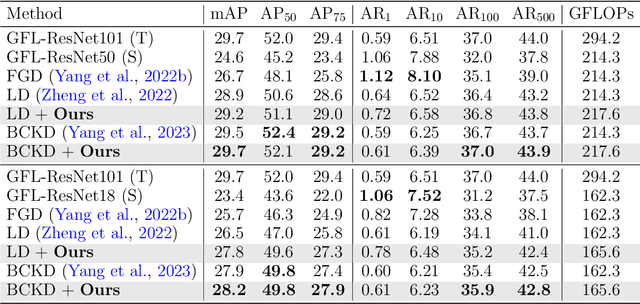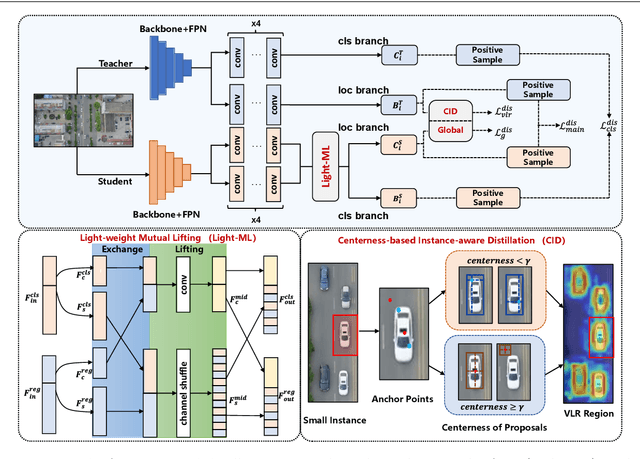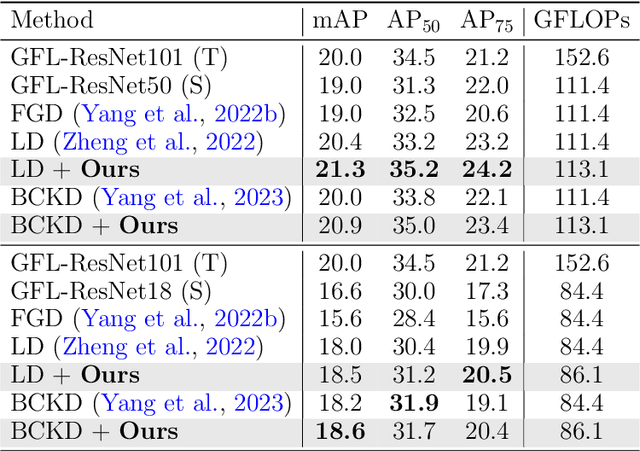Jiaxin Chen
FIMA-Q: Post-Training Quantization for Vision Transformers by Fisher Information Matrix Approximation
Jun 13, 2025Abstract:Post-training quantization (PTQ) has stood out as a cost-effective and promising model compression paradigm in recent years, as it avoids computationally intensive model retraining. Nevertheless, current PTQ methods for Vision Transformers (ViTs) still suffer from significant accuracy degradation, especially under low-bit quantization. To address these shortcomings, we analyze the prevailing Hessian-guided quantization loss, and uncover certain limitations of conventional Hessian approximations. By following the block-wise reconstruction framework, we propose a novel PTQ method for ViTs, dubbed FIMA-Q. Specifically, we firstly establish the connection between KL divergence and FIM, which enables fast computation of the quantization loss during reconstruction. We further propose an efficient FIM approximation method, namely DPLR-FIM, by employing the diagonal plus low-rank principle, and formulate the ultimate quantization loss. Our extensive experiments, conducted across various vision tasks with representative ViT-based architectures on public datasets, demonstrate that our method substantially promotes the accuracy compared to the state-of-the-art approaches, especially in the case of low-bit quantization. The source code is available at https://github.com/ShiheWang/FIMA-Q.
Decoding Speaker-Normalized Pitch from EEG for Mandarin Perception
May 26, 2025Abstract:The same speech content produced by different speakers exhibits significant differences in pitch contour, yet listeners' semantic perception remains unaffected. This phenomenon may stem from the brain's perception of pitch contours being independent of individual speakers' pitch ranges. In this work, we recorded electroencephalogram (EEG) while participants listened to Mandarin monosyllables with varying tones, phonemes, and speakers. The CE-ViViT model is proposed to decode raw or speaker-normalized pitch contours directly from EEG. Experimental results demonstrate that the proposed model can decode pitch contours with modest errors, achieving performance comparable to state-of-the-art EEG regression methods. Moreover, speaker-normalized pitch contours were decoded more accurately, supporting the neural encoding of relative pitch.
APHQ-ViT: Post-Training Quantization with Average Perturbation Hessian Based Reconstruction for Vision Transformers
Apr 03, 2025Abstract:Vision Transformers (ViTs) have become one of the most commonly used backbones for vision tasks. Despite their remarkable performance, they often suffer significant accuracy drops when quantized for practical deployment, particularly by post-training quantization (PTQ) under ultra-low bits. Recently, reconstruction-based PTQ methods have shown promising performance in quantizing Convolutional Neural Networks (CNNs). However, they fail when applied to ViTs, primarily due to the inaccurate estimation of output importance and the substantial accuracy degradation in quantizing post-GELU activations. To address these issues, we propose \textbf{APHQ-ViT}, a novel PTQ approach based on importance estimation with Average Perturbation Hessian (APH). Specifically, we first thoroughly analyze the current approximation approaches with Hessian loss, and propose an improved average perturbation Hessian loss. To deal with the quantization of the post-GELU activations, we design an MLP Reconstruction (MR) method by replacing the GELU function in MLP with ReLU and reconstructing it by the APH loss on a small unlabeled calibration set. Extensive experiments demonstrate that APHQ-ViT using linear quantizers outperforms existing PTQ methods by substantial margins in 3-bit and 4-bit across different vision tasks. The source code is available at https://github.com/GoatWu/APHQ-ViT.
Breaking the SSL-AL Barrier: A Synergistic Semi-Supervised Active Learning Framework for 3D Object Detection
Jan 26, 2025



Abstract:To address the annotation burden in LiDAR-based 3D object detection, active learning (AL) methods offer a promising solution. However, traditional active learning approaches solely rely on a small amount of labeled data to train an initial model for data selection, overlooking the potential of leveraging the abundance of unlabeled data. Recently, attempts to integrate semi-supervised learning (SSL) into AL with the goal of leveraging unlabeled data have faced challenges in effectively resolving the conflict between the two paradigms, resulting in less satisfactory performance. To tackle this conflict, we propose a Synergistic Semi-Supervised Active Learning framework, dubbed as S-SSAL. Specifically, from the perspective of SSL, we propose a Collaborative PseudoScene Pre-training (CPSP) method that effectively learns from unlabeled data without introducing adverse effects. From the perspective of AL, we design a Collaborative Active Learning (CAL) method, which complements the uncertainty and diversity methods by model cascading. This allows us to fully exploit the potential of the CPSP pre-trained model. Extensive experiments conducted on KITTI and Waymo demonstrate the effectiveness of our S-SSAL framework. Notably, on the KITTI dataset, utilizing only 2% labeled data, S-SSAL can achieve performance comparable to models trained on the full dataset.
Transforming Vision Transformer: Towards Efficient Multi-Task Asynchronous Learning
Jan 12, 2025



Abstract:Multi-Task Learning (MTL) for Vision Transformer aims at enhancing the model capability by tackling multiple tasks simultaneously. Most recent works have predominantly focused on designing Mixture-of-Experts (MoE) structures and in tegrating Low-Rank Adaptation (LoRA) to efficiently perform multi-task learning. However, their rigid combination hampers both the optimization of MoE and the ef fectiveness of reparameterization of LoRA, leading to sub-optimal performance and low inference speed. In this work, we propose a novel approach dubbed Efficient Multi-Task Learning (EMTAL) by transforming a pre-trained Vision Transformer into an efficient multi-task learner during training, and reparameterizing the learned structure for efficient inference. Specifically, we firstly develop the MoEfied LoRA structure, which decomposes the pre-trained Transformer into a low-rank MoE structure and employ LoRA to fine-tune the parameters. Subsequently, we take into account the intrinsic asynchronous nature of multi-task learning and devise a learning Quality Retaining (QR) optimization mechanism, by leveraging the historical high-quality class logits to prevent a well-trained task from performance degradation. Finally, we design a router fading strategy to integrate the learned parameters into the original Transformer, archiving efficient inference. Extensive experiments on public benchmarks demonstrate the superiority of our method, compared to the state-of-the-art multi-task learning approaches.
GeoPix: Multi-Modal Large Language Model for Pixel-level Image Understanding in Remote Sensing
Jan 12, 2025Abstract:Multi-modal large language models (MLLMs) have achieved remarkable success in image- and region-level remote sensing (RS) image understanding tasks, such as image captioning, visual question answering, and visual grounding. However, existing RS MLLMs lack the pixel-level dialogue capability, which involves responding to user instructions with segmentation masks for specific instances. In this paper, we propose GeoPix, a RS MLLM that extends image understanding capabilities to the pixel level. This is achieved by equipping the MLLM with a mask predictor, which transforms visual features from the vision encoder into masks conditioned on the LLM's segmentation token embeddings. To facilitate the segmentation of multi-scale objects in RS imagery, a class-wise learnable memory module is integrated into the mask predictor to capture and store class-wise geo-context at the instance level across the entire dataset. In addition, to address the absence of large-scale datasets for training pixel-level RS MLLMs, we construct the GeoPixInstruct dataset, comprising 65,463 images and 140,412 instances, with each instance annotated with text descriptions, bounding boxes, and masks. Furthermore, we develop a two-stage training strategy to balance the distinct requirements of text generation and masks prediction in multi-modal multi-task optimization. Extensive experiments verify the effectiveness and superiority of GeoPix in pixel-level segmentation tasks, while also maintaining competitive performance in image- and region-level benchmarks.
TCAQ-DM: Timestep-Channel Adaptive Quantization for Diffusion Models
Dec 21, 2024



Abstract:Diffusion models have achieved remarkable success in the image and video generation tasks. Nevertheless, they often require a large amount of memory and time overhead during inference, due to the complex network architecture and considerable number of timesteps for iterative diffusion. Recently, the post-training quantization (PTQ) technique has proved a promising way to reduce the inference cost by quantizing the float-point operations to low-bit ones. However, most of them fail to tackle with the large variations in the distribution of activations across distinct channels and timesteps, as well as the inconsistent of input between quantization and inference on diffusion models, thus leaving much room for improvement. To address the above issues, we propose a novel method dubbed Timestep-Channel Adaptive Quantization for Diffusion Models (TCAQ-DM). Specifically, we develop a timestep-channel joint reparameterization (TCR) module to balance the activation range along both the timesteps and channels, facilitating the successive reconstruction procedure. Subsequently, we employ a dynamically adaptive quantization (DAQ) module that mitigate the quantization error by selecting an optimal quantizer for each post-Softmax layers according to their specific types of distributions. Moreover, we present a progressively aligned reconstruction (PAR) strategy to mitigate the bias caused by the input mismatch. Extensive experiments on various benchmarks and distinct diffusion models demonstrate that the proposed method substantially outperforms the state-of-the-art approaches in most cases, especially yielding comparable FID metrics to the full precision model on CIFAR-10 in the W6A6 setting, while enabling generating available images in the W4A4 settings.
3D$^2$-Actor: Learning Pose-Conditioned 3D-Aware Denoiser for Realistic Gaussian Avatar Modeling
Dec 16, 2024



Abstract:Advancements in neural implicit representations and differentiable rendering have markedly improved the ability to learn animatable 3D avatars from sparse multi-view RGB videos. However, current methods that map observation space to canonical space often face challenges in capturing pose-dependent details and generalizing to novel poses. While diffusion models have demonstrated remarkable zero-shot capabilities in 2D image generation, their potential for creating animatable 3D avatars from 2D inputs remains underexplored. In this work, we introduce 3D$^2$-Actor, a novel approach featuring a pose-conditioned 3D-aware human modeling pipeline that integrates iterative 2D denoising and 3D rectifying steps. The 2D denoiser, guided by pose cues, generates detailed multi-view images that provide the rich feature set necessary for high-fidelity 3D reconstruction and pose rendering. Complementing this, our Gaussian-based 3D rectifier renders images with enhanced 3D consistency through a two-stage projection strategy and a novel local coordinate representation. Additionally, we propose an innovative sampling strategy to ensure smooth temporal continuity across frames in video synthesis. Our method effectively addresses the limitations of traditional numerical solutions in handling ill-posed mappings, producing realistic and animatable 3D human avatars. Experimental results demonstrate that 3D$^2$-Actor excels in high-fidelity avatar modeling and robustly generalizes to novel poses. Code is available at: https://github.com/silence-tang/GaussianActor.
MBL-CPDP: A Multi-objective Bilevel Method for Cross-Project Defect Prediction via Automated Machine Learning
Nov 10, 2024



Abstract:Cross-project defect prediction (CPDP) leverages machine learning (ML) techniques to proactively identify software defects, especially where project-specific data is scarce. However, developing a robust ML pipeline with optimal hyperparameters that effectively use cross-project information and yield satisfactory performance remains challenging. In this paper, we resolve this bottleneck by formulating CPDP as a multi-objective bilevel optimization (MBLO) method, dubbed MBL-CPDP. It comprises two nested problems: the upper-level, a multi-objective combinatorial optimization problem, enhances robustness and efficiency in optimizing ML pipelines, while the lower-level problem is an expensive optimization problem that focuses on tuning their optimal hyperparameters. Due to the high-dimensional search space characterized by feature redundancy and inconsistent data distributions, the upper-level problem combines feature selection, transfer learning, and classification to leverage limited and heterogeneous historical data. Meanwhile, an ensemble learning method is proposed to capture differences in cross-project distribution and generalize across diverse datasets. Finally, a MBLO algorithm is presented to solve this problem while achieving high adaptability effectively. To evaluate the performance of MBL-CPDP, we compare it with five automated ML tools and $50$ CPDP techniques across $20$ projects. Extensive empirical results show that MBL-CPDPoutperforms the comparison methods, demonstrating its superior adaptability and comprehensive performance evaluation capability.
Centerness-based Instance-aware Knowledge Distillation with Task-wise Mutual Lifting for Object Detection on Drone Imagery
Nov 05, 2024



Abstract:Developing accurate and efficient detectors for drone imagery is challenging due to the inherent complexity of aerial scenes. While some existing methods aim to achieve high accuracy by utilizing larger models, their computational cost is prohibitive for drones. Recently, Knowledge Distillation (KD) has shown promising potential for maintaining satisfactory accuracy while significantly compressing models in general object detection. Considering the advantages of KD, this paper presents the first attempt to adapt it to object detection on drone imagery and addresses two intrinsic issues: (1) low foreground-background ratio and (2) small instances and complex backgrounds, which lead to inadequate training, resulting insufficient distillation. Therefore, we propose a task-wise Lightweight Mutual Lifting (Light-ML) module with a Centerness-based Instance-aware Distillation (CID) strategy. The Light-ML module mutually harmonizes the classification and localization branches by channel shuffling and convolution, integrating teacher supervision across different tasks during back-propagation, thus facilitating training the student model. The CID strategy extracts valuable regions surrounding instances through the centerness of proposals, enhancing distillation efficacy. Experiments on the VisDrone, UAVDT, and COCO benchmarks demonstrate that the proposed approach promotes the accuracies of existing state-of-the-art KD methods with comparable computational requirements. Codes will be available upon acceptance.
 Add to Chrome
Add to Chrome Add to Firefox
Add to Firefox Add to Edge
Add to Edge